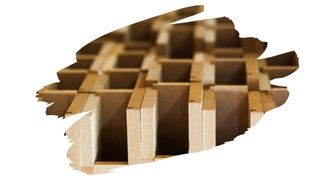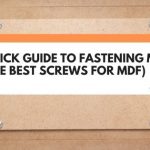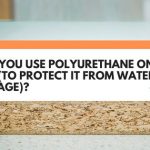Floors should be made from strong materials that can hold up furniture, cabinetry, and people walking overhead. What’s more, floors need to be made from durable material that won’t rot away at the first hint of moisture.
It’s a hard job, but there must be a material that’s capable of doing all that, right? But, is MDF in particular, one such material?
Well, in this post, you will learn why (and how) MDF has traditionally been used for flooring. You’ll also find out what the biggest problem is with using MDF for in a kitchen or bathroom.
And keep reading to discover which special type of MDF is so water-resistant, it can even be used outside.

This post may contain affiliate links to products that we receive a commission for (at no additional cost to you). Learn more here.
Can You Really Use MDF For Flooring?
You can, but it tends to be used as underlayment, not for floors.
Underlayment is the material placed in between the subfloor and floor. And the general job of underlayment is to provide insulation and soundproofing.
And What’s The Purpose Of Using MDF For Underlayment?
Decades ago, MDF was popularly used as underlayment because it was affordable.
On top of that, MDF is a better insulator than solid hardwood alone. And, for a manufactured wood composite, it has some soundproofing qualities too.
So Can You Use MDF Under Vinyl Or Laminate Flooring?
In theory, there’s nothing stopping you. MDF is a firm material that won’t shift around, the way newly installed hardwood floors can.
Related Post: Do New Hardwood Floors Need To Settle? (Explained!)
And, MDF is much denser (and therefore more stable) than particle board — which is another widely used underlayment material.
Having said that, in practice, you are much better off looking elsewhere for flooring material.
What Are Some Of The Biggest MDF Flooring Problems?
It’s not so much that it has a plethora of problems. Instead, it’s that MDF has one big flaw.
And it’s that particular flaw that leads to a range of different issues further down the line.
You see, MDF is all too easily water-damaged. And this material will absorb moisture at the drop of a hat.
In fact, MDF’s super-absorbency is the reason why water-based glues and finishes don’t work on it. Why? Well, because MDF will absorb the water from those glues/finishes too quickly for them to set properly.
Related Post: A Quick Guide To Fastening MDF (+ The Best Screws For MDF)
And once MDF gets any moisture in it, it is next to impossible to fix that water damage. So, placing MDF in any room that will have steam in it, (i.e. the Bathroom or Kitchen), is a bad idea.
On top of that, MDF isn’t that strong and doesn’t do great as a load-bearing material. It isn’t even as strong, rigid, or as stable, as plywood, (which is popularly used for flooring).
Related Post: What Is The Best Type Of Plywood For A Van Floor? (Solved!)
Does This Mean That Using MDF For Flooring Means That It Can Mold Easily?
Well, standard MDF will start to mold in damp conditions. What’s more, once MDF becomes water-damaged, it pretty much stays that way.
This is because the damp inside bacteria-riddled MDF never really dries out enough to stop mold from coming back.
At best, you can treat moldy MDF with fungicides. But, unless you throw out damp MDF altogether, that mold will be there to stay.
Having said that, there are some expensive types of MDF that are surprisingly water-resistant.
Exterior-Grade MDF isn’t a wholly waterproof material, and it will still need to be properly sealed. Nevertheless, it is less likely to suffer from the worst effects of water-damage.
And What Makes Exterior Grade MDF So Special?
Well, the key characteristic of exterior grade MDF is it’s density. This special MDF has more wood shavings packed into it. And this in turn makes it more stable and less water-absorbent.
This makes exterior graded MDF suitable for non-structural outdoor projects. So, it can be used for things such as shop signs and outdoor displays. But, it is not a load-bearing structural material.
In short, exterior grade MDF is better than standard MDF, when it comes to water-resistance. But, it offers little advantage when it comes to it’s load-bearing capabilities (which is important for flooring).
What Does This Mean For My Dreams Of Saving Money With MDF For Flooring?
Using MDF to save money on floor installation is pretty much the textbook definition of the term ‘false economy’.
You will save money in the short run. However, over the long run, it’s going to cost you a lot more maintaining that easily damaged MDF floor.
To Wrap Up, Here Are The 3 Key Takeaways From This Post…
1). MDF does not have much load-bearing strength. Compared to plywood, this manufactured wood is a poor choice for flooring or underlayment.
2). MDF is easily water-damaged. And in high humidity environments, such as the kitchen or bathroom, it can quickly succumb to mold and decay.
3). There are exterior-graded MDF boards you can buy. They are much more water-resistant than standard MDF. However, they too, are not suitable for structural projects (like floors).



